Electromagnetic Exposure Levels of Electric Vehicle Drive Motors to Passenger Wearing Cardiac Pacemakers
Abstract
:1. Introduction
2. Numerical Calculation Methods and Model Construction
2.1. Numerical Calculation Method
2.2. Electric Vehicle Body Model
2.3. Passenger Model Wearing a Pacemaker
2.3.1. Human Body Model and Related Parameters
2.3.2. Pacemaker Model
2.4. Electromagnetic Environment Model
3. Analysis of the Calculation Results
3.1. Distribution of Electric Field Intensity in the Carriage
3.2. Distribution of Induced Electric Field in the Passenger’s Body
3.3. Distribution of Induced Electric Field in the Heart
3.4. Specific Absorption Rate of Human Body
3.5. Specific Absorption Rate of Heart
3.6. Temperature Rise of the Human Body
3.7. Temperature Rise of the Heart
3.8. Temperature Rise of the Pacemaker
4. Discussion
5. Conclusions
Author Contributions
Funding
Institutional Review Board Statement
Informed Consent Statement
Data Availability Statement
Acknowledgments
Conflicts of Interest
References
- Li, X. Research on development problems and countermeasures of new energy vehicles under the background of low-carbon economy. Automot. Test Rep. 2023, 18, 62–64. [Google Scholar]
- Omahne, V.; Knez, M.; Obrecht, M. Social aspects of electric vehicles research—Trends and relations to sustainable development Goals. World Electr. Veh. J. 2021, 12, 15. [Google Scholar] [CrossRef]
- Gryz, K.; Karpowicz, J.; Zradziński, P. Complex electromagnetic issues associated with the use of electric vehicles in urban transportation. Sensors 2022, 22, 1719. [Google Scholar] [CrossRef] [PubMed]
- Fotescu, R.P.; Svasta, P.; Burciu, L.M.; Constantinescu, R. Electromagnetic and electric field radiation inside electric vehicles and classic vehicles. In Proceedings of the 2022 IEEE 28th International Symposium for Design and Technology in Electronic Packaging (SIITME), Bucharest, Romania, 26–29 October 2022. [Google Scholar]
- Yang, L.; Lu, M.; Lin, J.; Li, C.; Zhang, C.; Lai, Z.; Wu, T. Long-Term Monitoring of Extremely Low Frequency Magnetic Fields in Electric Vehicles. Int. J. Environ. Res. Public Health 2019, 16, 3765. [Google Scholar] [CrossRef] [PubMed]
- Hristov, R.; Stefanov, S.; Kostov, P. Investigation of the electromagnetic field in electric and hybrid cars. In Proceedings of the 26th Technical and Scientific Conference “Transport, Ecology—Sustainable Development”, Varna, Bulgaria, 8–10 October 2020. [Google Scholar]
- Vassilev, A.; Ferber, A.; Wehrmann, C.; Pinaud, O.; Schilling, M.; Ruddle, A.R. Magnetic field exposure assessment in electric vehicles. IEEE Trans. Electromagn. Compat. 2014, 57, 35–43. [Google Scholar] [CrossRef]
- Xu, H.; Wang, G.; Tong, J.; Li, F. Monitoring and analysis of exposure level of magnetic field intensity in electric vehicle. Environ. Monitor. 2022, 14, 47–52. [Google Scholar]
- Che, K.; Yu, J.; Yang, P.; Wei, M.; Liu, S.; Li, D. Limits of electromagnetic environment for electric vehicle wireless power transfer. In Proceedings of the 13th IEEE PES Asia Pacific Power & Energy Engineering Conference (APPEEC), Thiruvananthapuram, India, 21–23 November 2021. [Google Scholar]
- Liu, S.; Li, D.; Chen, C.; Jia, W.; Che, K.; Yu, J. Electromagnetic Field Safety Analysis of a 7.7 kW Wireless Power Transfer System for Electric Vehicles. Prog. Electromagn. Res. M 2023, 117, 1–12. [Google Scholar] [CrossRef]
- Bae, H.; Park, S.W. Assessment of the electromagnetic radiation exposure at EV charging facilities. Sensors 2023, 23, 162. [Google Scholar] [CrossRef] [PubMed]
- ICNIRP. Guidelines for limiting exposure to time-varying electric and magnetic Fields (1 Hz to 100 kHz). Health Phys. 2010, 99, 818–836. [Google Scholar]
- Xiao, J.; Gao, C.; Li, Z.; Zhang, K.; Jia, J.; Zhang, D. Research on Electromagnetic Effect Generated by DC Converter on Human Body in Electric Vehicle. In Proceedings of the IEEE 97th Vehicular Technology Conference (VTC2023-Spring), Florence, Italy, 20–23 June 2023. [Google Scholar]
- Hakuta, Y.; Watanabe, T.; Takenaka, T.; Ito, T.; Hirata, A. Safety standard compliance of human exposure from vehicle cables using coupling factors in the frequency range of 0.3–400 kHz. IEEE Trans. Electromagn. Compat. 2020, 63, 313–318. [Google Scholar] [CrossRef]
- Wang, J.; Mu, S.; Hai, Z. Research on the influence of electromagnetic radiation in the automobile on the SAR value of human body. In Proceedings of the International Seminar on Artificial Intelligence, Networking and Information Technology, Shanghai, China, 18–20 September 2020. [Google Scholar]
- Concha, P.M.T.; Velez, P.; Lafoz, M.; Arribas, J.R. Passenger exposure to magnetic fields due to the batteries of an electric vehicle. IEEE Trans. Veh. Technol. 2016, 65, 4564–4571. [Google Scholar] [CrossRef]
- Dong, X.; Gao, Y.; Lu, M. The Electromagnetic exposure level of a pure electric vehicle inverter based on a real human body. Appl. Sci. 2024, 14, 32. [Google Scholar] [CrossRef]
- Tan, L.; Li, G.; Xie, Q.; Xiang, Y.; Luo, B. Study on the safety assessment and protection design of human exposure to low-frequency magnetic fields in electric vehicles. Radiat. Prot. Dosim. 2024, 200, 60–74. [Google Scholar] [CrossRef] [PubMed]
- Benini, M.; Parazzini, M.; Bonato, M.; Gallucci, S.; Chiaramello, E.; Fiocchi, S.; Tognola, G. Road user exposure from ITS-5.9 GHz vehicular connectivity. Sensors 2022, 22, 6986. [Google Scholar] [CrossRef]
- Tognola, G.; Benini, M.; Bonato, M.; Gallucci, S.; Parazzini, M. Assessment of the variability of human exposure to radiofrequency electromagnetic fields arising from 5.9 GHz vehicular communication in urban environments. Sensors 2023, 23, 6802. [Google Scholar] [CrossRef]
- Zhao, J.; Wu, Z.J.; Li, N.L.; Yang, T. Study on safe distance between human body and wireless charging system of electric vehicles with different power and frequencies. Electr. Eng. 2020, 102, 2281–2293. [Google Scholar] [CrossRef]
- Mensah, G.A.; Fuster, V.; Roth, G.A. A Heart-Healthy and Stroke-Free World: Using Data to Inform Global Action. J. Am. Coll. Cardiol. 2023, 82, 2343–2349. [Google Scholar] [CrossRef] [PubMed]
- Mydlová, J.; Gálová, I.; Beňová, M. Impact of electromagnetic fields in transport on active implantable medical devices. In Proceedings of the 13th International Scientific Conference on Sustainable, Modern and Safe Transport, Novy Smokovec, Slovak Republic, 29–31 May 2019. [Google Scholar]
- Chen, C.; Cole, W.; Bronte-Stewart, H.M. Hybrid cars may interfere with implanted deep brain stimulators. Mov. Disord. 2009, 24, 2290–2291. [Google Scholar] [CrossRef] [PubMed]
- Dawson, T.W.; Caputa, K.; Stuchly, M.A.; Shepard, R.B.; Kavet, R.; Sastre, A. Pacemaker interference by magnetic fields at power line frequencies. IEEE Trans. Biomed. Eng. 2002, 49, 254–262. [Google Scholar] [CrossRef] [PubMed]
- Scholten, A.; Silny, J. The interference threshold of unipolar cardiac pacemakers in extremely low frequency magnetic fields. J. Med. Eng. Technol. 2001, 25, 185–194. [Google Scholar]
- Driessen, S.; Napp, A.; Schmiedchen, K.; Kraus, T.; Stunder, D. Electromagnetic interference in cardiac electronic implants caused by novel electrical appliances emitting electromagnetic fields in the intermediate frequency range: A systematic review. Europace 2019, 21, 219–229. [Google Scholar] [CrossRef] [PubMed]
- Huang, J.; Lin, K.; Lu, W.; Ding, R.; Wu, B.; Cai, M.; Nazarian, S.; Zhao, W. An in vitro evaluation of the effect of transient electromagnetic fields on pacemakers and clinical mitigation measures. Front. Cardiovasc. Med. 2020, 7, 607604. [Google Scholar] [CrossRef] [PubMed]
- Tian, R.; Li, W.X.; Lu, M.; Yu, L.; Zhang, J.Q. Research on the influence of power frequency magnetic field of pantograph on pacemaker wearers’ health in high-speed EMU. Radiat. Prot. Dosim. 2024, 200, 588–597. [Google Scholar] [CrossRef] [PubMed]
- Wang, T.; Li, B.; Zhao, K.; Yu, Q.; Xu, L.; Chi, Y.; Guan, S. Evaluation of Electromagnetic Exposure of the Human with a Coronary Stent Implant from an Electric Vehicle Wireless Power Transfer Device. Electronics 2023, 12, 4231. [Google Scholar] [CrossRef]
- Shah, I.A.; Cho, Y.; Yoo, H. Safety evaluation of medical implants in the human body for a wireless power transfer system in an electric vehicle. IEEE Trans. Electromagn. Compat. 2020, 63, 681–691. [Google Scholar] [CrossRef]
- Lennerz, C.; Horlbeck, L.; Weigand, S.; Grebmer, C.; Blazek, P.; Brkic, A.; Semmler, V.; Haller, B.; Reents, T.; Hessling, G.; et al. Patients with pacemakers or defibrillators do not need to worry about e-Cars: An observational study. Technol. Health Care 2020, 28, 1–12. [Google Scholar] [CrossRef]
- Shah, I.A.; Yoo, H. Assessing human exposure with medical implants to electromagnetic fields from a wireless power transmission system in an electric vehicle. IEEE Trans. Electromagn. Compat. 2019, 62, 338–345. [Google Scholar] [CrossRef]
- Campi, T.; Cruciani, S.; De Santis, V.; Feliziani, M. EMF safety and thermal aspects in a pacemaker equipped with a wireless power transfer system working at low frequency. IEEE Trans. Microw. Theory 2016, 64, 375–382. [Google Scholar] [CrossRef]
- Zhai, L.; Zhang, X.; Bondarenko, N.; Loken, D.; Van Doren, T.P.; Beetner, D.G. Mitigation emission strategy based on resonances from a power inverter system in electric vehicles. Energies 2016, 9, 419. [Google Scholar] [CrossRef]
- Peng, H.M.; Wang, Q.D.; Yang, Y.M. Electromagnetic radiation emission model of motor drive system. Appl. Mech. Mater. 2015, 764, 501–505. [Google Scholar] [CrossRef]
- Chen, C.; Zhou, H.Q. Electromagnetic interference prediction technology of new energy motor drive system. Appl. Math. Nonlinear Sci. 2023, 8, 625–638. [Google Scholar] [CrossRef]
- Zhang, G.; Kong, F.; Wang, J.; Ai, Q.; Gu, R.; Sun, Y. Research on radiated interference of motor driven converter of electric vehicle. In Proceedings of the IEEE 4th International Conference on Electronic Information and Communication Technology (ICEICT), Xi’an, China, 18–20 August 2021. [Google Scholar]
- ICNIRP. Guidelines for limiting exposure to electromagnetic fields (100 kHz to 300 GHz). Health Phys. 2020, 118, 483–524. [Google Scholar] [CrossRef] [PubMed]
- Pennes, H.H. Analysis of tissue and arterial blood temperatures in the resting human forearm. J. Appl. Physiol. 1948, 1, 93–122. [Google Scholar] [CrossRef] [PubMed]
- Haussmann, N.; Mease, R.; Zang, M.; Stroka, S.; Hensel, S.; Clemens, M. Efficient high-resolution electric and magnetic field simulations inside the human body in the vicinity of wireless power transfer systems with varying models. Compel 2023, 42, 903–913. [Google Scholar] [CrossRef]
- Gabriel, C.; Gabriel, S.; Corthout, E. The dielectric properties of biological tissues: I. Literature survey. Phys. Med. Biol. 1996, 41, 2231–2249. [Google Scholar] [CrossRef] [PubMed]
- Lu, W. Antenna Theory and Technology, 1st ed.; Xidian University Press: Xi’an, China, 2004; pp. 50–123. [Google Scholar]
- Pan, Z. Electromagnetic Wave, Antenna and Radio Wave Propagation, 1st ed.; China Machine Press: Beijing, China, 2003; pp. 254–345. [Google Scholar]
- Li, X.; Li, Y.; Zhang, R.; Su, Z.; Han, N. Research on efficient simulation method of electromagnetic radiation inside pure electric vehicle. J. North Univ. China 2018, 39, 508–514. [Google Scholar]
- ICNIRP. Guidelines for limiting exposure to time-varying electric, magnetic, and electromagnetic fields (up to 300 GHz). Health Phys. 1998, 74, 494–522. [Google Scholar]
- ISO 14708-2:2019; Implants for Surgery—Active Implantable Medical Devices—Part 2: Cardiac Pacemakers. ISO: Geneva, Switzerland, 2019.

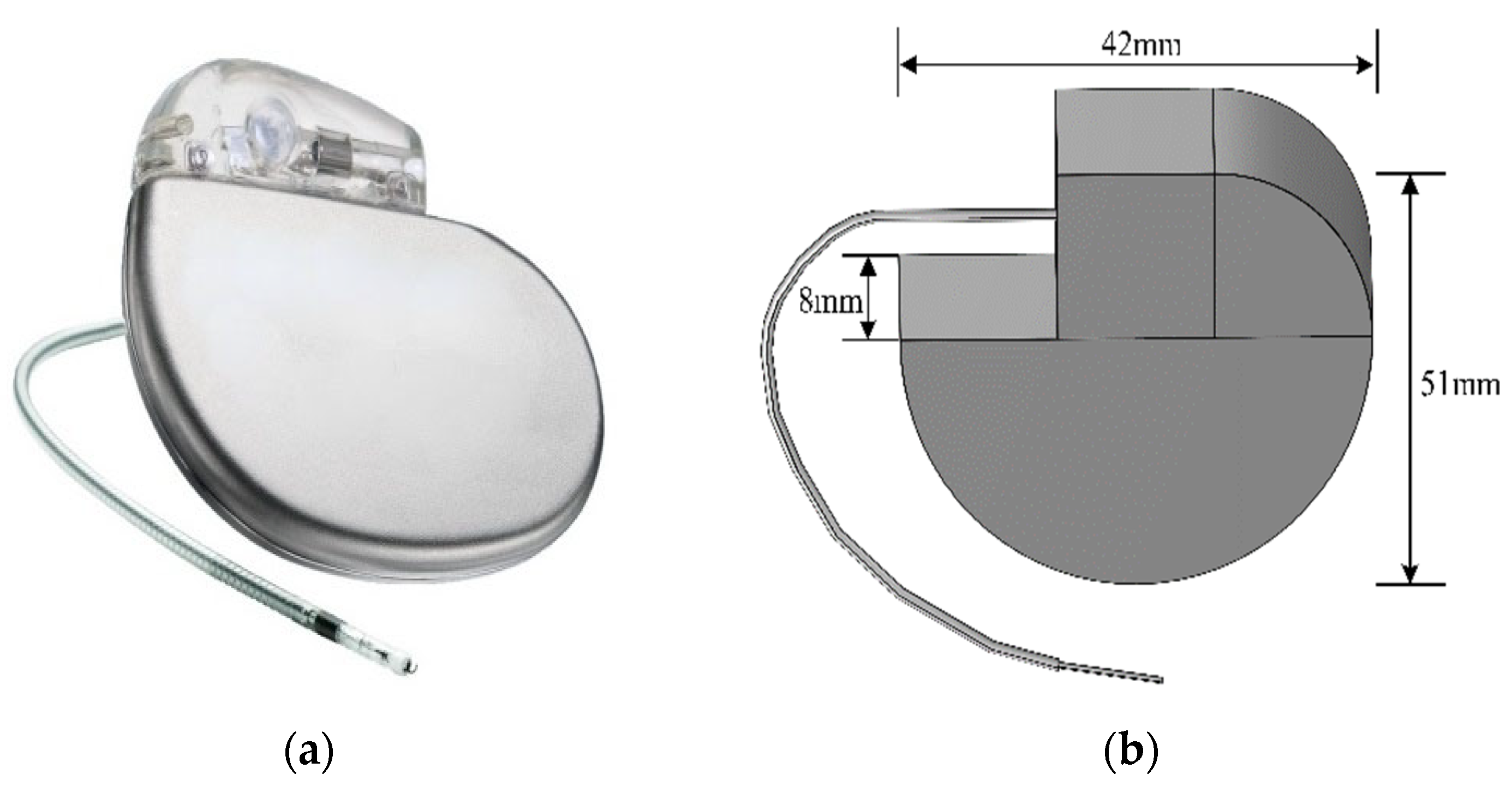

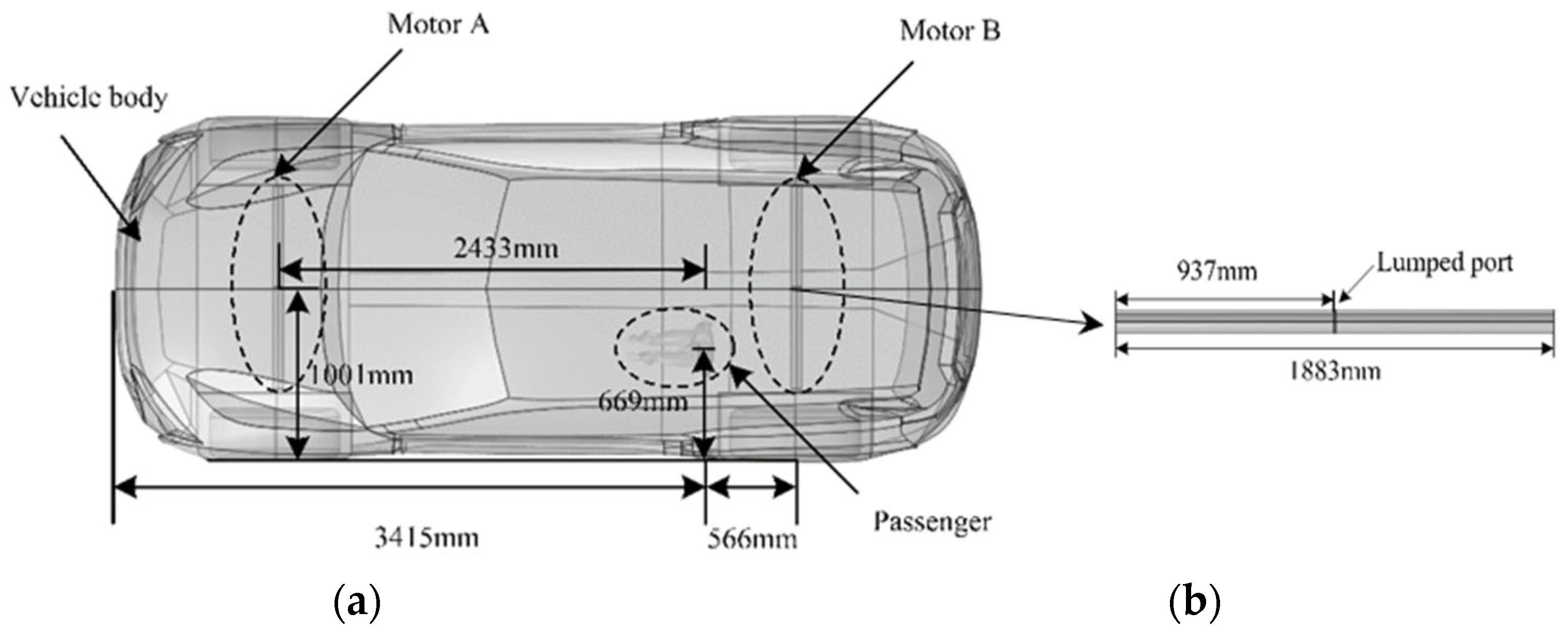

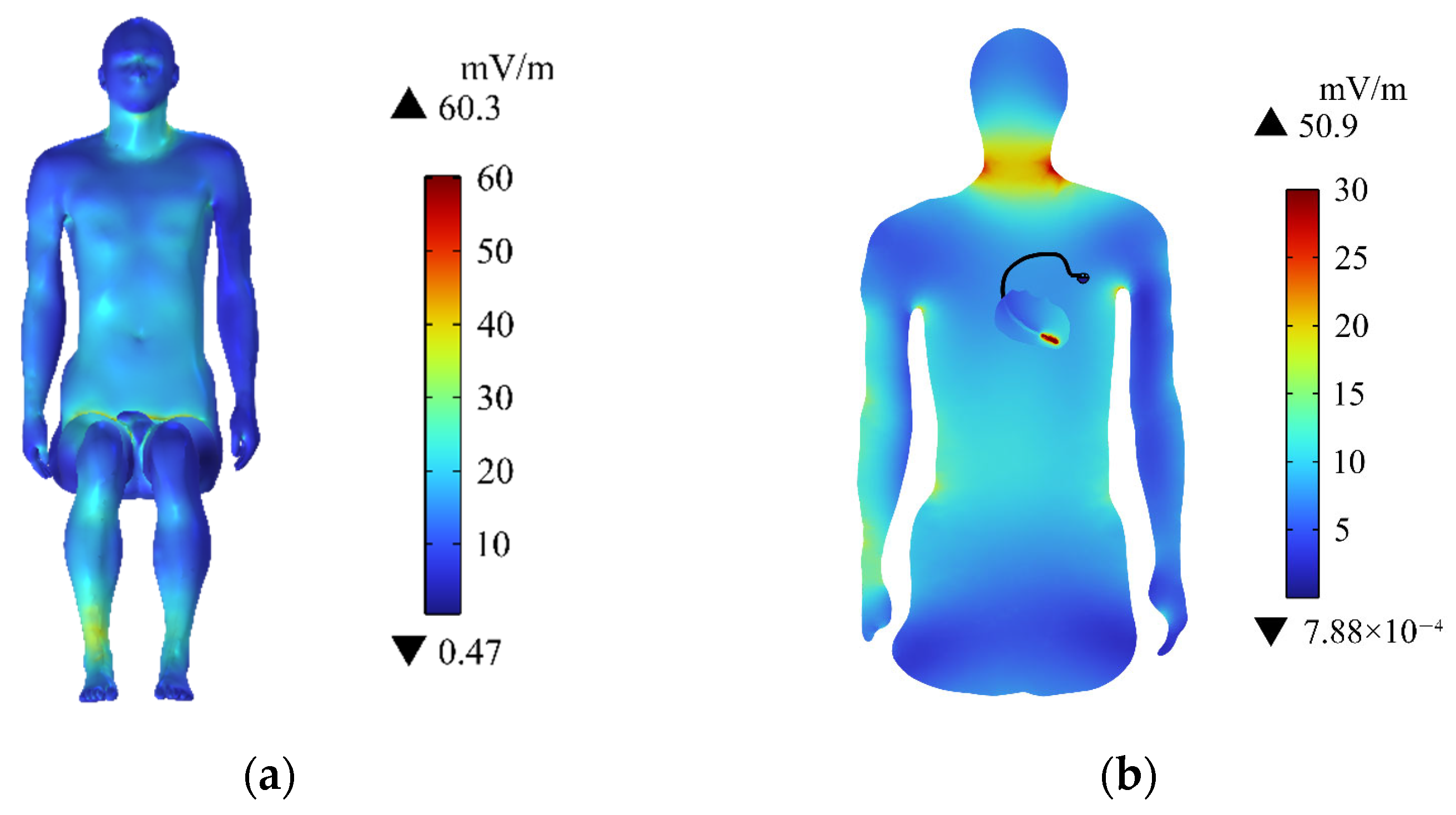


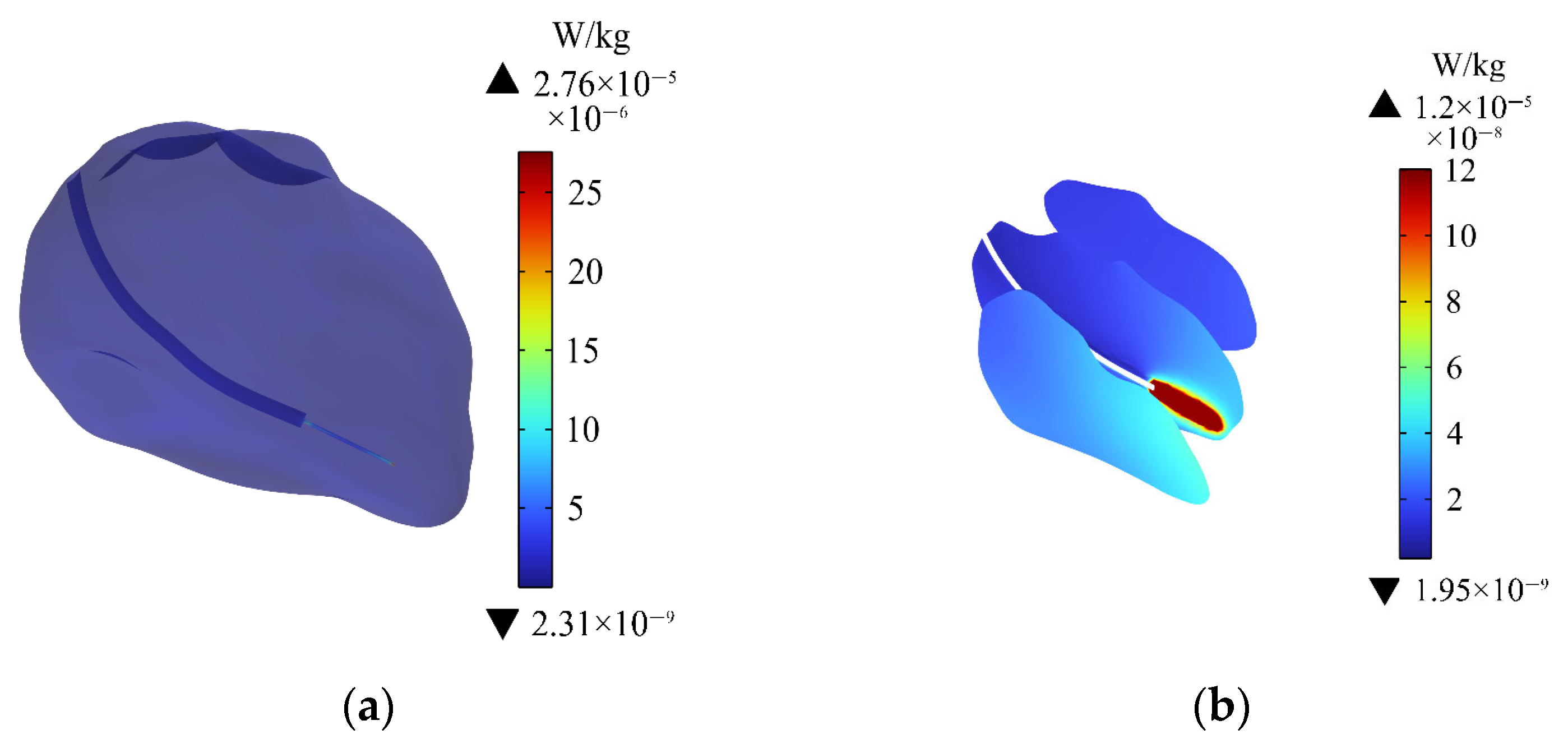
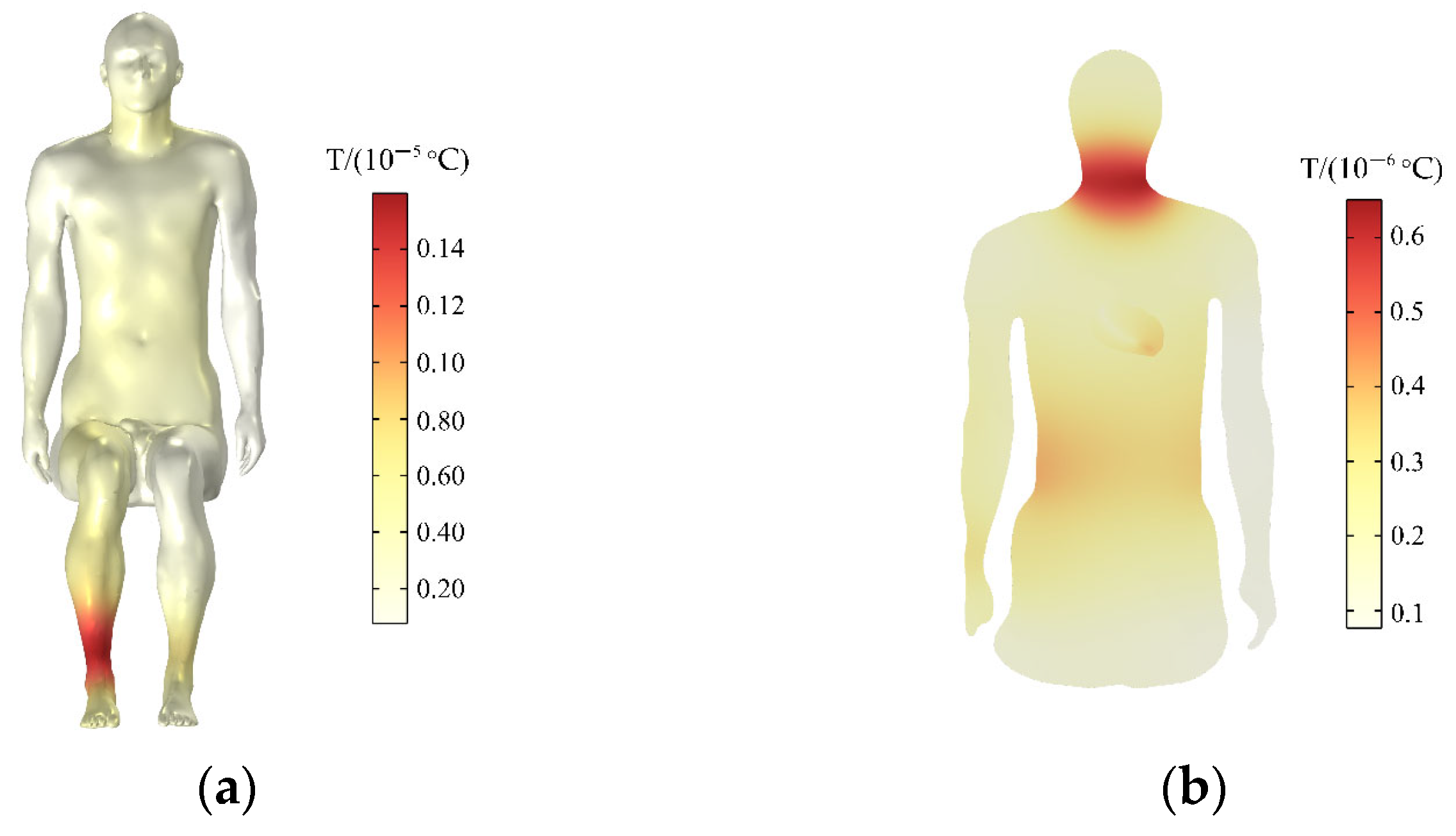
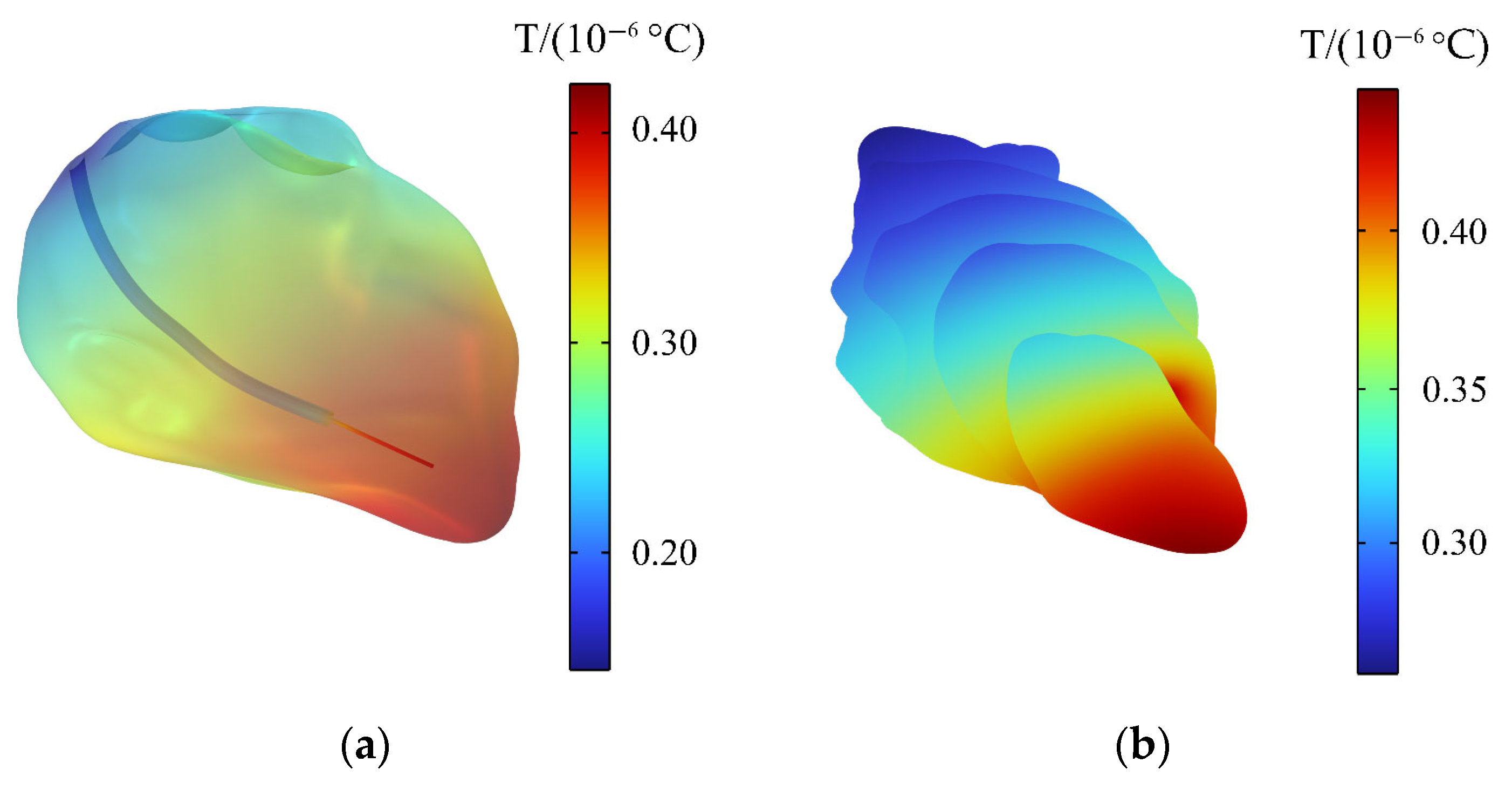
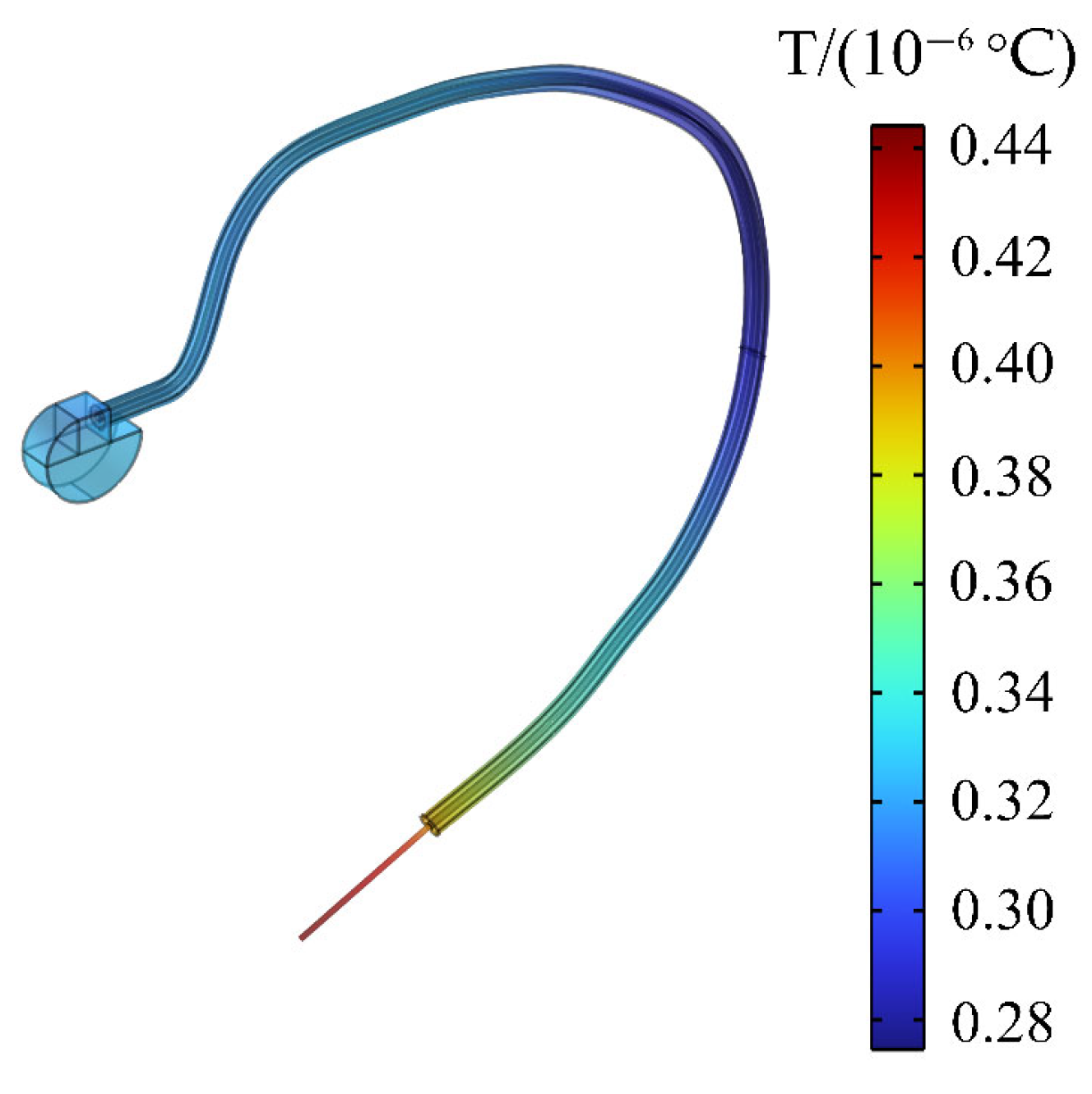
| Tissue | C | 1/s | ||||
|---|---|---|---|---|---|---|
| skin | 0.4843 | 76.1495 | 1109 | 3391 | 0.37 | 0.0016 |
| blood | 1.2196 | 81.0520 | 1050 | 3617 | 0.52 | — |
| muscle | 0.6977 | 68.7690 | 1090 | 3421 | 0.49 | 0.00056 |
| Bone | 0.1783 | 27.6897 | 1908 | 1313 | 0.32 | 0.000087 |
| heart | 0.7049 | 97.9640 | 1059 | 1.22 | 0.43 | 0.02 |
| Cardiac Pacemaker Parameters | Material or Size |
|---|---|
| Cardiac pacemaker casing | Titanium |
| Electrode conductor | Platinum-iridium alloy |
| Insulating layer | Silicone rubber |
| Connector module | 75D polyurethane |
| Geometric parameters (H × W × D) | 51 mm × 42 mm × 8 mm |
| Surface area | |
| Quality | 21 g |
Disclaimer/Publisher’s Note: The statements, opinions and data contained in all publications are solely those of the individual author(s) and contributor(s) and not of MDPI and/or the editor(s). MDPI and/or the editor(s) disclaim responsibility for any injury to people or property resulting from any ideas, methods, instructions or products referred to in the content. |
© 2024 by the authors. Licensee MDPI, Basel, Switzerland. This article is an open access article distributed under the terms and conditions of the Creative Commons Attribution (CC BY) license (https://creativecommons.org/licenses/by/4.0/).
Share and Cite
Dong, X.; Qian, Y.; Lu, M. Electromagnetic Exposure Levels of Electric Vehicle Drive Motors to Passenger Wearing Cardiac Pacemakers. Sensors 2024, 24, 4395. https://doi.org/10.3390/s24134395
Dong X, Qian Y, Lu M. Electromagnetic Exposure Levels of Electric Vehicle Drive Motors to Passenger Wearing Cardiac Pacemakers. Sensors. 2024; 24(13):4395. https://doi.org/10.3390/s24134395
Chicago/Turabian StyleDong, Xuwei, Yidan Qian, and Mai Lu. 2024. "Electromagnetic Exposure Levels of Electric Vehicle Drive Motors to Passenger Wearing Cardiac Pacemakers" Sensors 24, no. 13: 4395. https://doi.org/10.3390/s24134395





